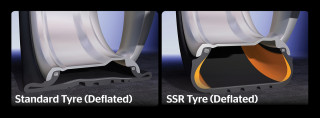Runflat Tyres
Runflat Tyres: What are they and why do you need to know?
Runflat tyres are tyres that are designed to be able to be driven for a short time deflated, for example after they get a puncture. They’re specced by some European vehicle manufacturers as an alternative to fitting the car with a spare tyre. They’re generally designed to be able to run for up to 80 km at up to 80 km/hr – which in theory should be enough to get you to a tyreshop or garage without the inconvenience of fitting a spare tyre to get there.

But here’s what you need to know: You should only fit runflats to a vehicle that’s been designed for runflats. And you should only fit standard tyres to a vehicle that’s been designed for standard tyres. Why? For starters, vehicles that are designed to take runflats don’t have a spare tyre. So you might be only 80 km from a garage when your tyre goes down, but it’s going to be a mighty long walk to get there. But even more critically for when you’re driving and before your tyre has gone flat, runflat tyres have much stiffer sidewalls than standard tyres. A car that’s designed for runflat tyres will have its suspension tuned to give a comfortable ride on runflats. Put anything else on and you’re going to get a ride that’s at best sloppy and at worst dangerous.
If your vehicle isn’t designed for runflat tyres, they might seem like a convenient and appealing option. But the same thing with the suspension applies the other way around – if your vehicle was tuned for standard tyres, its going to be a horrible ride on runflats.
How can you tell whether a tyre has a runflat construction?
Runflat tyres can be identified by a marking on the sidewall. These can vary but the most common ones are as follows:
Continental – SSR
Dunlop – DSST or ROF
Goodyear – ROF or EMT
Bridgestone - ROF or RFT or RSC
Michelin – ZP
Hankook – tyres will be marked with HRS or have B at the end of the product number (e.g. K115B)
Pirelli – RSC
Yokohama – ZPS
A few other key points:
- Runflat tyres should never be mixed with standard tyres. If you’ve listened to us on the above points this won’t be a problem, but seriously. Don’t. Ever. Do. It. It’s dangerous and the resultant handling of your vehicle will be extremely scary.
- It’s illegal to fit runflats to a vehicle which doesn’t have a Tyre Pressure Monitoring System (TPMS) installed. Why? Because if you get a puncture you otherwise won’t know. And run it too far over the 80 km/hr for 80 km and the tyre will eventually disintegrate… which is pretty dangerous when it happens at high speeds.
- SSR tyres should never be repaired. This means getting a puncture can be an expensive experience with runflats. But this isn’t about your tyreshop trying to make more sales. It’s because the construction of runflat tyres mean that it’s very difficult to ascertain whether or not the tyre suffered structural damage at the time of the puncture, which could mean a dangerous tyre failure down the track.